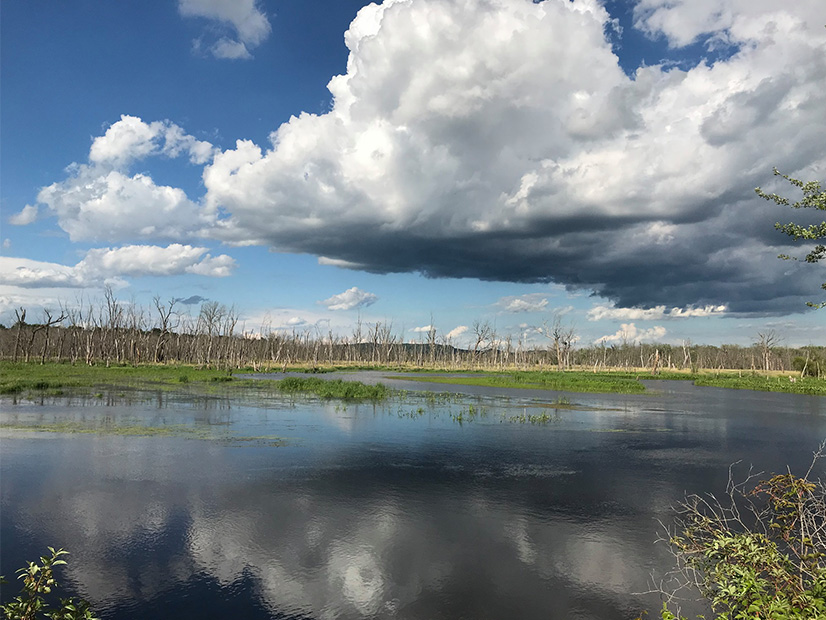The Cardinal-Hickory Creek transmission project is “incompatible” with southwestern Wisconsin’s protected Driftless Area, a federal judge ruled last week in blocking construction in the region.
U.S. District Judge William Conley, with the Western District of Wisconsin, forbade the nearly $500 million, 101-mile 345-kV line from southwest Wisconsin to Iowa from making a beeline through the Upper Mississippi River National Fish and Wildlife Refuge (21-cv-096-wmc). A final judgement is pending.
Conley said project developers American Transmission Co. (ATC), ITC Midwest and Dairyland Power Cooperative violated federal environmental laws to secure permits for the line. He said clear-cutting and construction of transmission towers in the refuge would fragment habitat, adversely impact wildlife breeding, and permanently alter forest succession patterns — all “clear contradictions with the refuge’s purposes.”
ATC, ITC Midwest and Dairyland planned to begin opening up the project’s Wisconsin portion in early November. However, Conley agreed with several conservation groups and issued a preliminary injunction against the line. (See Conservation Groups Win Injunction vs. Cardinal-Hickory Creek.)
The utilities framed the line as a minor project in need of “a relocated right of way that results in a disturbance of some 30 or so acres … in the context of a 240,000-acre refuge.”
However, in a ruling last Friday, Conley said the route would cut through the heart of the refuge, disturbing 39 acres of land. He said the utilities had only secured permitting for nine of the acres.
Conley struck down the utilities’ arguments that one of the conservation groups didn’t have standing to sue and that the case was moot because they applied for a land transfer as an alternative to their right-of-way permit request.
The judge said that U.S. Fish and Wildlife Service, the agency responsible for right-of-way easement and special-use permits to cross the Upper Mississippi River National Wildlife and Fish Refuge, seemed to be “working hand-in-glove” with ATC, ITC and Dairyland. He said the only other line route alternative offered was a “nearly identical crossing” that indicated the service and the utilities were committed to carving a path through the refuge.
Conley pointed out that the utilities first sought a right of way in 2020, then an amended right of way, and later dropped the requests altogether. They recently proposed a land transfer with Fish and Wildlife instead of a permitting process.
“Suspiciously, all of these actions took place in the months after this case was filed,” Conley wrote, calling the sequence of events “thin porridge.”
“While the utilities have waffled between seeking another right of way or land transfers, at no point has Fish and Wildlife or the utilities suggested that the CHC would not cross the refuge,” Conley said. He said even if a new administrative record for a land exchange was opened, Fish and Wildlife would likely complete a nearly identical analysis to its right-of-way request.
Conley said the government agencies and utilities “appear to be playing a shell game, cavalierly revoking applications for and grants of permits.”
He also pointed out that Congress wrote the National Wildlife Refuge System Improvement Act of 1997 in order “to curb incompatible, secondary uses within refuges.”
“An incompatible use cannot become compatible simply by converting it to a land transfer,” he wrote.
Conley also ruled that the line’s environmental impact statement, prepared by the U.S. Department of Agriculture’s Rural Utilities Service, was inadequate and failed to comply with the National Environmental Policy Act (NEPA).
Conservation groups Wisconsin Wildlife Federation, Driftless Area Land Conservancy, National Wildlife Refuge Association, and Defenders of Wildlife argued in May that developers and government agencies ignored environmental harms when authorizing the line.
Conley said it didn’t appear that the utilities considered increasing the transfer capability of nearby existing lines or pursuing electric storage projects as alternatives to major new construction.
He said it appeared that the Rural Utilities Service simply parroted MISO’s reasoning for proposing the line instead of independently scrutinizing the line’s functions. A decade ago, the RTO said the line would relieve transmission congestion, boost reliability and facilitate more interconnections of renewable generation to the grid. MISO also said Cardinal-Hickory Creek would negate the need for more than a dozen smaller line upgrades in the vicinity.
“Because RUS adopted MISO’s convoluted purpose statement, which then drastically narrowed the alternatives reviewed in the [environmental impact statement], that purpose statement fails to comply with NEPA,” Conley said.
The Cardinal-Hickory Creek line is the last of MISO’s $6.7 billion, 17-project Multi-Value Project portfolio approved in 2011.
Developers Vow Line’s Completion
In a statement, ATC, ITC Midwest and Dairyland said the judge’s ruling has “no immediate impact on the co-owners’ ability to continue construction activities” after the first injunction was issued. The companies pointed out that a final judgement has yet to be issued and that they are to provide briefs on remedies by Jan. 24.
“The utilities are committed to completing this project, which will reduce energy costs, improve electric grid reliability, relieve congestion on the transmission system, support decarbonization goals and help support the interconnection of renewable generation in the Upper Midwest,” the utilities said.
Environmental Law and Policy Center attorney Howard Learner, representing the conservation groups, said it was clear that Cardinal-Hickory Creek’s route would harm the refuge and said it’s time for the developers to consider alternatives.
“Running a huge high-voltage transmission line with 20-story high towers through the national wildlife refuge is illegal and is contrary to common sense and sound policy,” he said in an emailed statement.
Learner said the permanent injunction “makes clear that the agencies and the transmission companies essentially rigged the environmental impact statement process to preclude fairly evaluating alternatives to the huge, proposed transmission line.”
He said there exist “less expensive alternatives, that are less environmental damaging to the scenic Driftless Area’s vital natural resources, family farms and communities, and that create more local opportunities for clean energy progress in Wisconsin.”



